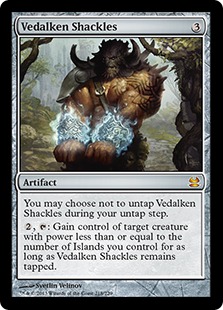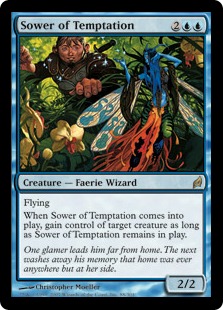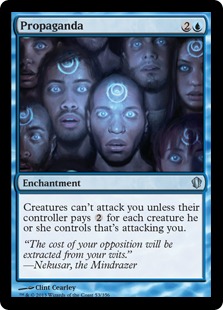When I was perusing the forums over at The Mana Drain a couple weeks back, I gravitated towards a thread discussing Mono-Blue Control, also known as “MUC”. Naturally, I was skeptical that a deck forced to play only one color could be competitive in Vintage. What the deck lacked seemed like it would be too difficult to overcome with the narrow card pool of only blue cards. Of course, blue is the most powerful color in Magic, so I should have known better than to doubt its potential.
The first known MUC list to show up in paper this year was Matthew Murray’s list from a tournament in Bloomsburg in early August (6th-place finish in 18 person tourney). The deck really started to get some attention when Miguel Angel Díaz split first place in a 33-player tournament in Badalona with the following list:
MUC by Miguel Angel Díaz
|
| ||||||||
MTGO user “Chubby Rain” may have been the first player to really build MUC as they were able to finish in the money in some Vintage DEs at the end of July. It’s possible that Matthew Murray is Chubby Rain, but I’ll assume they are two different people for the sake of this article. Nonetheless, in the last few weeks, MUC has picked up a couple of prominent Magic players: Eric Froehlich and David Williams. Both players are currently piloting this deck in the Vintage Super League.
With that kind of weight behind the deck, I was determined to try it out myself. Unfortunately, I don’t have any recorded matches to share with you this week as we’ve had some difficulty getting Vintage DEs to fire (a story for another day), but I did get my fair share of matches in with the deck in the Tournament Practice room, enough for me to discuss my thoughts on the deck with all of you today.
First, let me share my most recent list:
MUC-ing Around with Thassa by enderfall
|
| ||||||||
Thoughts on the Deck
There are only a few changes to the maindeck, while the sideboards are mainly identical. First, let’s evaluate the strengths of the deck. Anyone familiar with the “Draw-GO” decks of yesteryear will quickly recognize the similarities between the decks. Unlike the grindy, plodding pace that a deck like Standstill offers, MUC is more reactive. Standstill tries to create a board advantage and then lock opponents under a Standstill while ticking Jace up by 2 turn after turn, or attacking with Mishra’s Factory over and over again. MUC is a little different. It tries to manage the game until it can drop a win condition on the table and then ride that to victory.
It may sound like the same thing, but in my playtesting, there was a subtle difference where it felt like even if I was behind on board, I could draw into an answer and quickly turn the game around. Standstill decks always felt to me like they needed to get an early advantage and then land the namesake card in order to win. Once the deck got behind, it was difficult to recover, but more experienced Standstill pilots may disagree. Granted, I didn’t get to try this deck out extensively against all of the decks in the format, so faster creature-based decks might give this deck some trouble. With the sheer amount of countermagic in the deck, it seemed like creature decks weren’t too big of an obstacle. Nonetheless, there are options out of the sideboard to deal with creature swarms.
Another obvious advantage that the deck has is its invulnerability to Wasteland. This is not a small detail. Against Workshop decks, you never have to worry about getting blown out by a Wasteland or two. Your fetch lands are then free to sit in play until you absolutely need them to find a land, which also allows you to use their shuffle effect better than any multi-color Control deck in the format that depends on fetch lands to find the right color mana that they need.
Back to Basics can really catch people off-guard. Against some decks, like Workshop, it’s almost a one-sided Armageddon. Other times it’s a double Stone Rain that pitches to Force of Will. Finding the right time to cast the card can be a little awkward, and like Blood Moon, after a player has seen it once, they are much more likely to play around it. Nonetheless, it can offer some “free wins” often enough to warrant keeping it in the deck, and is an excellent way to sink Mana Drain mana into after your opponent has tapped out to cast a spell. Speaking of which…
At heart, this is a Mana Drain deck. The countermagic suite is designed in such a way to help bridge the gap in the first couple of turns of the game to get to double-blue mana safely. Mental Misstep, Spell Snare, and Force help to navigate Turns 1 and 2, allowing you to sit on Drain until you need it. Of course, that won’t always be the correct line of play as sometimes you’ll need to force the issue and jam down an early Trinket Mage or Jace, but often, it’s critical for the deck to take advantage of Drain, especially to help ramp up to the 6 mana required to cast Consecrated Sphinx.
The one “counter” I was pleasantly surprised with was Mindbreak Trap. In more than a few cases, I was able to fire this off on the Draw on Turn 1 to exile a critical spell. With the number of Moxen/Lotus and other cheap mana spells in the format (Sol Ring, Dark Ritual, etc.), it’s not uncommon to be able to fire off a Trap for free in the early turns of the game, even without your opponent storming out. Against Workshop decks, I was able to counter things like Lodestone Golem after they dropped 2 Moxen and an Ancient Tomb. Storm decks I was able to counter Necropotence after they fired off a Mox and a Ritual first. Later in the game it can simply counter a spell, or help win a counter war. Best of all, it stops Abrupt Decay cold, even if there aren’t many quality targets for it in the deck.
Trinket Mage is a unique card in the Vintage cardpool. The ability to search out a specific piece of hate, a Mox/Lotus, or a Sensei’s Divining Top gives the deck a nice little tutor engine that it would otherwise lack. In this way, Trinket Mage can find a Grafdigger’s Cage against Oath, Storm, or Dredge, a Sensei’s Top against other control/creature decks, or can be a mana-ramping 2/2.
Top is the best way for MUC to be able to dig for cards and is an excellent choice to search for with Trinket Mage. In a way, it is the best replacement for the black tutors.
One card that has been discussed as a necessary part of the Tinket package is Engineered Explosives. As is, it’s a 2-mana “destroy all Moxes” card which furthers the mana-denial plan. It can also handle Zombie and Young Pyromancer/Empty the Warrens tokens. With the help of 1 or more off-color Moxen, it can also remove 1- or 2-CMC cards.
One of the few “broken” things the deck can do is use Trinket to act as a mana ramp spell. Conveniently, with 3 mana to cast the mage, it can find a Lotus to help launch the deck to get to 6 mana, which happens to be the exact cost to cast this guy:
Until recently, few people ever would have thought seeing Consecrated Sphinx in Vintage would be possible. The card did see a little play back in 2012 in some versions of UW Bomberman, but had otherwise been forgotten for roughly 2 years. What makes the card so powerful right now is that few, if any, decks are playing Swords to Plowshares (StP), which is really the only card that can deal with Sphinx besides a Jace. Removal packages in most decks consist of Lightning Bolt, [card[Abrupt Decay[/card], and/or Dismember. Sphinx dodges all of those. Even if your opponent is playing with StP, they need to have it right then and there, or you’ll be able to reload your hand with 2 cards during their next draw step. Once on the table, the sheer card advantage you gain will likely be able to protect the Sphinx, and in the air, it usually has a clear path to beat face.
The rest of the deck is filled with cards you’ll typically find in any Blue Control deck: Time Walk, Ancestral Recall, Snapcaster Mage, etc.
There is one card people are probably very surprised to see: Thassa, God of the Sea. As a 1-of in a deck without any way to tutor for it, I’ve not had too many chances to play it, but it has helped me win some games. What’s difficult to determine is whether they were “win-more” instances and if I would have preferred it to be a different card. For now, it will stay in my deck. The upside to Thassa is quite interesting. Scry 1 every turn for free is not to be dismissed. It’s especially good with Jace, as you can dig deeper into your deck without having to use a fetch land to shuffle the top of your library. All you need to do is simply put the card you don’t want at the top of your deck after you “Jace-storm” and on the following turn, Scry it to the bottom with Thassa. The other ability, making a creature unblockable, hasn’t come up yet, but I could see it mattering at some point in time, such as when your Sphinx is staring down a Steel Hellkite, or you need to get past a Trygon Predator.
Turning on devotion isn’t as hard as it seems. Between Trinket Mage, Jace, Back to Basics, Sphinx, and Vendilion Clique in the main deck, I’ve been able to attack with Thassa on a couple of occasions. There are other cards I would consider playing instead of Thassa, but for now, I’m sticking with her until I find a glaring weakness. Some of the other cards I would consider in the main deck:
Sideboard Options
The sideboard is full of some juicy cards that have some wide-ranging impact in the format.
Artifact decks are still a problem, despite the deck’s strength against Wasteland and how good Back to Basics is against them. The unfortunate reality is that sometimes, they can just run away from you before you even get a chance to cast anything.
These are all Trinket Mage targets that are mainly here to fight Dredge. Pithing Needle also has the flexibility to turn off opposing planeswalkers, fetch lands, and other cards, too, in a pinch.
In the last 3 years, only one deck on morphling.de piloted a winning deck with Propaganda in the sideboard. While not surprised by this, I did find it discouraging before I was able to play some matches. Quite simply, it can really shut down decks that are designed to win in the “red zone”. As more decks head down that path, I could see Propaganda being played a little more often. It is particularly deadly against Dredge decks. It is not easy for Dredge to get to 2 mana to be able to attack with just a simple creature, especially when they are fighting hate from other angles, such as Cage or Crypt. Against BUG and Pyromancer decks (with or without Delver), Propaganda can also do some work. What happens is players have to choose to attack or cast spells. Either way, they are tapping lands and that makes them even more susceptible to Back to Basics. It’s not great against all decks, especially Tinker decks, so it’s best left in the sideboard. I look forward to testing this card out even more in the future.
Another card I might consider against creature decks is AEtherspouts (see also, Evacuation, Curse of the Swine, and Cyclonic Rift). At 5 mana, it’s quite expensive, but as far as blue sweepers go, it’s probably the best option available.
Weaknesses
Next, I’d like to talk about the weaknesses of the deck. First, the lack of color splashes means that MUC can’t afford to run combo cards such as Time Vault/Voltaic Key, which also makes Tinker less attractive (it’s a dead card if Blightsteel Colossus gets stuck in your hand). The biggest factor of being mono-blue is that blue lacks any actual removal. It can bounce things back to hand, which is why Repeal is in the maindeck as pseudo-removal, but it can’t really deal with anything once it hits the board. For this reason, Dismember is in the sideboard. It is the only creature removal that can be cast without the need to splash another color.
Another weakness that the deck has it that it lacks any broken-ness. There are never any “oops, I win” moments with this deck like there are with Storm, Workshop, Oath, Dredge, and other blue Control decks with Tinker-Vault-Key. It requires players to manage the flow of the game, as one mistake can cost the game against some of those decks listed above. Nonetheless, the deck still has the tools to get out of most situations.
Another Area Worth Exploring?
There are several ways I could envision taking this deck in the future. Naturally, the new cards in Khans of Tarkir like Treasure Cruise and Dig Through Time could find a home in a deck like this. Dig seems like it would be a little better as it acts more like a tutor than just the raw card advantage of Cruise.
Beyond those, however, I can certainly see this deck taking a much more mana-denial approach. Back to Basics is a great start, but adding in Null Rod and maybe even Stifle can take the mana-denial theme to the next level. I’m dying to try such a deck out, but Stifle is incredibly expensive right now, and I haven’t gotten around to ponying up the price to get a set of them. If I did have Stifles, this is likely where I’d start (note, this is a rough sketch):
Blue Prison by enderfall
|
| ||||||||
What do you think about MUC? Do you think it’s a deck that has legs over the next few months in Vintage, or is it a shot in the dark? Let me know your thoughts in the comments!
enderfall
Clan Magic Eternal
Follow me on Twitter @enderfall























